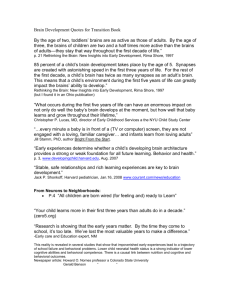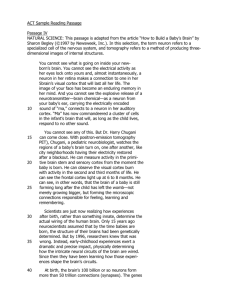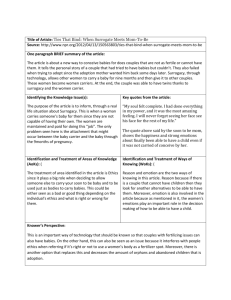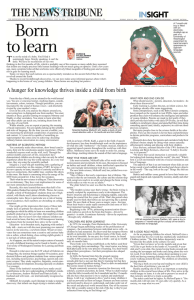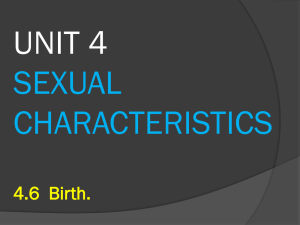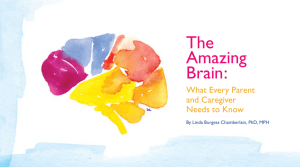WLit.CTD.AF.Reading Passage Practice Thursday
advertisement
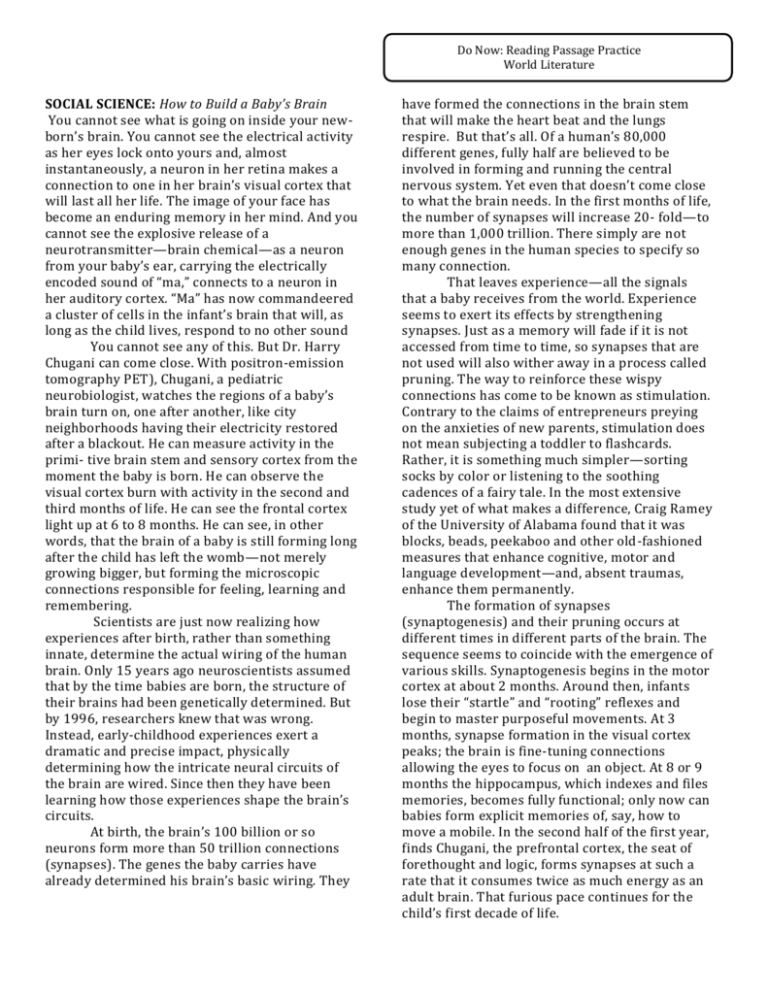
Do Now: Reading Passage Practice World Literature SOCIAL SCIENCE: How to Build a Baby’s Brain You cannot see what is going on inside your newborn’s brain. You cannot see the electrical activity as her eyes lock onto yours and, almost instantaneously, a neuron in her retina makes a connection to one in her brain’s visual cortex that will last all her life. The image of your face has become an enduring memory in her mind. And you cannot see the explosive release of a neurotransmitter—brain chemical—as a neuron from your baby’s ear, carrying the electrically encoded sound of “ma,” connects to a neuron in her auditory cortex. “Ma” has now commandeered a cluster of cells in the infant’s brain that will, as long as the child lives, respond to no other sound You cannot see any of this. But Dr. Harry Chugani can come close. With positron-emission tomography PET), Chugani, a pediatric neurobiologist, watches the regions of a baby’s brain turn on, one after another, like city neighborhoods having their electricity restored after a blackout. He can measure activity in the primi- tive brain stem and sensory cortex from the moment the baby is born. He can observe the visual cortex burn with activity in the second and third months of life. He can see the frontal cortex light up at 6 to 8 months. He can see, in other words, that the brain of a baby is still forming long after the child has left the womb—not merely growing bigger, but forming the microscopic connections responsible for feeling, learning and remembering. Scientists are just now realizing how experiences after birth, rather than something innate, determine the actual wiring of the human brain. Only 15 years ago neuroscientists assumed that by the time babies are born, the structure of their brains had been genetically determined. But by 1996, researchers knew that was wrong. Instead, early-childhood experiences exert a dramatic and precise impact, physically determining how the intricate neural circuits of the brain are wired. Since then they have been learning how those experiences shape the brain’s circuits. At birth, the brain’s 100 billion or so neurons form more than 50 trillion connections (synapses). The genes the baby carries have already determined his brain’s basic wiring. They have formed the connections in the brain stem that will make the heart beat and the lungs respire. But that’s all. Of a human’s 80,000 different genes, fully half are believed to be involved in forming and running the central nervous system. Yet even that doesn’t come close to what the brain needs. In the first months of life, the number of synapses will increase 20- fold—to more than 1,000 trillion. There simply are not enough genes in the human species to specify so many connection. That leaves experience—all the signals that a baby receives from the world. Experience seems to exert its effects by strengthening synapses. Just as a memory will fade if it is not accessed from time to time, so synapses that are not used will also wither away in a process called pruning. The way to reinforce these wispy connections has come to be known as stimulation. Contrary to the claims of entrepreneurs preying on the anxieties of new parents, stimulation does not mean subjecting a toddler to flashcards. Rather, it is something much simpler—sorting socks by color or listening to the soothing cadences of a fairy tale. In the most extensive study yet of what makes a difference, Craig Ramey of the University of Alabama found that it was blocks, beads, peekaboo and other old-fashioned measures that enhance cognitive, motor and language development—and, absent traumas, enhance them permanently. The formation of synapses (synaptogenesis) and their pruning occurs at different times in different parts of the brain. The sequence seems to coincide with the emergence of various skills. Synaptogenesis begins in the motor cortex at about 2 months. Around then, infants lose their “startle” and “rooting” reflexes and begin to master purposeful movements. At 3 months, synapse formation in the visual cortex peaks; the brain is fine-tuning connections allowing the eyes to focus on an object. At 8 or 9 months the hippocampus, which indexes and files memories, becomes fully functional; only now can babies form explicit memories of, say, how to move a mobile. In the second half of the first year, finds Chugani, the prefrontal cortex, the seat of forethought and logic, forms synapses at such a rate that it consumes twice as much energy as an adult brain. That furious pace continues for the child’s first decade of life. 1. The main point of this passage is to: A. illustrate the importance of genetics in the formation of a baby’s brain. B. illustrate the importance of stimulation and experience in the formation of a baby’s brain. C. indicate the great need for conducting further research on babies’ brains. D. compare the latest research on babies’ brains with similar research conducted fifteen years ago. 2. As it is used in line 12, the word commandeered most nearly means: A. B. C. D. taken allowed forbidden destroyed 3. The last paragraph (lines 80-99) suggests that the formation of synapses occurs most rapidly: A. during the first two months of a child’s life B. during the first nine months of a child’s life C. from the time a child is about six months old until that child is about ten years old D. from the time a child is about one year old until that child is well into adolescence 4. As it is used in line 33-34, the phrase something innate most nearly means: A. B. C. D. a memory learned behavior physical immaturity an inherited trait 5. It can be inferred from the third paragraph (lines 32-44) that the experiences of babies: A. are important in forming their brains B. are not as important in forming their brains as scientists always thought C. are important in forming their physical features D. are not extremely important in forming their height and weight 6. It can be inferred from the fifth paragraph (lines 60-79) that one of the main causes of pruning is: A. B. C. D. a lack of stimulation an insufficient number of genes the use of flashcards the strengthening of synapses 7. When the author refers to “entrepreneurs preying on the anxieties of new parents” (lines 68-69), she is most likely suggesting that new parents should: A. give their babies products such as flashcards only if they have examined these products carefully B. not be deceived by advertising that claims certain products will increase a baby’s intelligence C. not worry if their babies’ development is slightly behind that suggested by neurobiologists D. take their pediatrician’s advice before they listen to the advice given by other family members 8. The passage states that, in terms of development, the average baby should be able to: A. focus his or her eyes on an object beginning at two months of age B. develop a “startle” reflex at about two months of age C. make logical connections between ideas at about four months of age D. form explicit memories at about nine months of age


